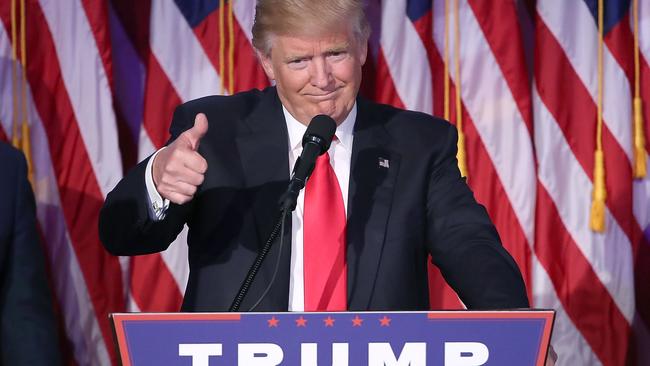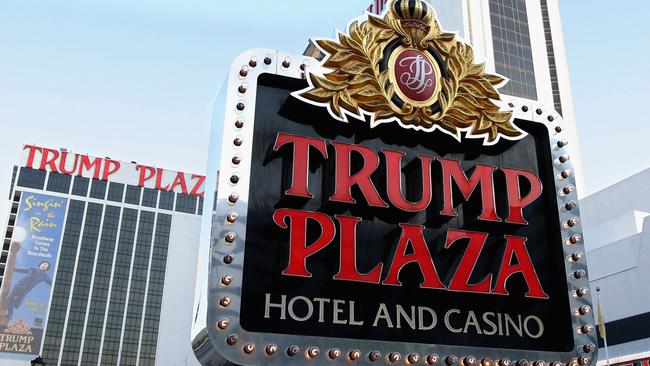Hold onto your mortgages: What Trump means for the global economy
DONALD Trump’s economic policies have been tried before, and with a triple-whammy heading our way, Australians should be worried.

OPINION
DESPITE all the dire predictions, Donald Trump’s economic plan is not totally incoherent and we’ve actually lived through it before.
You may disagree with his policies, but they have a long history, and coincided with America’s longest economic boom after World War II.
It just breaks with four decades of consensus about how the American economy should be run, and who should benefit.
In the short term, the impact on Australia is likely to minimal, but by the time Mr Trump faces voters again in four years’ time, the global economy is likely to be radically different to today. And that will have a big impact on Australians. Especially if you have a mortgage.
BRING BACK PROTECTIONISM
At the heart of Trumpism is the age-old concept of protectionism.
Many Americans (and Australians) fondly look back at 1950s and 1960s as eras of great prosperity. In fact, Donald Trump’s whole campaign was about appealing to the nostalgia of those ‘simpler’ times.
It’s important to remember that the 1950s and 1960s was an era of relatively high tariffs and trade barriers: Exactly what Trump wants to reintroduce.
Protectionism isn’t all bad news: but it is a very different way of running the economy. Protectionism is a pact between government, business and workers. By protecting local businesses, the expectation is that businesses then protect local workers with higher wages, and more stable employment. This is the style of economy that Donald Trump is aiming for.
LOCK OTHER COUNTRIES OUT
It is worth noting, however, that the cost of doing this is also immense. During the post-World War II boom, the practical consequence of protectionism was to lock poorer countries out of global trade.
The reason for this is fairly simple: If you’re trying to run your economy with the aim of prioritising local businesses and jobs, you don’t want to trade with nations that have lower wages than you.
The opening up of the American economy under Ronald Reagan in the 1980s and then Bill Clinton in the 1990s shows you why. As trade opened up, firms discovered that wages were much lower in poorer countries, and moved the operations to those countries.
That’s how the rust belt happened. Car factories, fridge factories, toy factories all started leaving. If you think, like Mr Trump does, that it’s important to keep those sort of businesses in your own country then you aim to restrict trade with lower-wage countries.
Of course, it doesn’t mean there was no international trade. During the 1950s and 1960s, the US had bilateral trade deals with other rich countries in Europe, and Australia. These were nations that didn’t threaten US businesses or jobs, because the cost of wages was about the same.
But during that period, the US (and the rest of the rich world) had far less trade with poorer countries in Asia and Africa.
It’s no coincidence that the rise of Asia as an economically prosperous region happened during the 1980s and 1990s, the exact period that Mr Trump labels as a “disaster” for America.

AN ASIAN RECESSION IS COMING
Mr Trump’s trade policies will most impact Mexico, but it will also have a massive impact on low-wage countries in our region.
China may be big enough to defend its economy, but it simply doesn’t have the consumer base to soak up the manufacturing output of poorer Asian countries like Cambodia, Malaysia, Indonesia and Bangladesh.
The probability that Asia’s growth will falter off the back of Mr Trump’s trade policies is almost certain. The probability of an Asian recession in the next four years is a near certainty.
But for Australia, at least, it’s a storm we can probably manage. Our wages are higher than America’s and so for the moment, it is likely that America will see Australia as a good bilateral trading partner. The calculation would be, “well, if we trade with the Aussies, then the cost base for their firms will be about the same as our firms, so it won’t undercut our local businesses.”
INFLATION IS COMING
But Mr Trump is not just a protectionist. When it comes to taxes, he’s a starry-eyed Reaganite. One of the tricks that Ronald Reagan used as he was abolishing protectionism and opening up the US economy to globalisation was to fund the growth in the domestic economy by slashing taxes.
This was largely seen as irresponsible at the time, mainly because it created massive deficits, and dire predictions that the US government would go bankrupt.
In fact, nothing of the sort happened. US government debt soared, but nobody really cared. The US dollar retained its position, and the extra stimulus that the tax cuts provided, simply fuelled inflation that then spread to the rest of the globe.
This all makes sense. Think of expanding government debt as essentially being the same as printing money: The government is increasing the amount of money available in the economy, without making any more goods or services available in the economy.
This is naturally an inflationary thing to do: Prices go up because there is more money out there, competing for the same amount of stuff. So prices rise. Nobody gets any richer, but everything costs a bit more.
This is in stark contrast to the way George W. Bush used debt to stimulate the economy in the aftermath of 9/11. Instead of increasing government debt, Bush’s policies unleashed private debt. People massively increased their home mortgages, which in turn fuelled economic growth between 2001 and 2007.
This was arguably far more destructive for the average America. It meant that when the reckoning came, people were personally on the hook for the debt bubble. Mr Trump’s policies at least mean that if the bubble bursts, everyone will suffer. He’s socialising the debt, like Reagan did.
Under Bush’s policies, middle-class homeowners found themselves on the hook for the debt that had kept the economy spluttering along for everyone.
RUNNING THE ECONOMY LIKE A CASINO

In many ways, Mr Trump’s tax policy seems to indicate he is hoping to fuel growth in the US economy much like the way he ran Trump Casino: Run up massive debts making sure those debts are held not by anyone personally but by a company, enjoy the easy money while it lasts, and then when the unsustainable debt burden leads to a collapse into bankruptcy, make sure he’s not personally on the hook for any of the bad debt.
If you swap out Trump Casino and replace it with America, that’s basically his plan to drive economic growth.
All this is highly inflationary over the long term. Inflation will ultimately mean that the US dollar starts to slide in value. As it takes more money to buy the same amount of stuff, the relative value of each dollar will decline.
This is arguably good in the short term for a national, protectionist economy, but as the country accumulates more debt, the decline in the US dollar will get bigger and bigger.
HOW WILL MORTGAGES BE EFFECTED?
During the campaign, Mr Trump said he wanted to replace the Federal Reserve Chair Janet Yellen. She has been a dove on interest rates. Whoever her replacement is, will – in three or four years’ time — find themselves faced with a declining dollar and rising inflation.
In that scenario, there is only one response possible: Interest rates will start to rise. This will protect the value of the US dollar and it’ll put a lid on inflation.
And that’s where Australians really need to worry. Australia currently has, by some figures, the highest household debt ratios in the world. This is private debt. We’ve been living in our own mortgage-debt fuelled bubble of growth since the GFC.
If interest rates start rising rapidly in the United States, our Reserve Bank will have no choice but to eventually follow suit here. And that’s when Australia finds itself in a tough situation: Rising interest rates, no extra growth, and perhaps a recession in Asia.
As I say, these things don’t happen overnight, but it’s a triple-whammy that scares the hell out of me.
Professor Charles Firth is not really a professor but he did major in Economic (Social Science) at Sydney University. He is also editor of The Chaser Quarterly. Follow him on Twitter @charlesfirth



